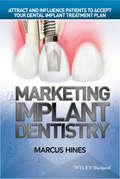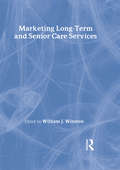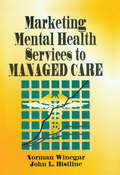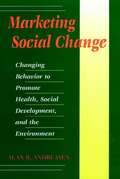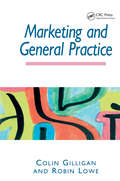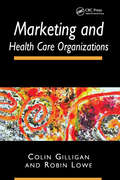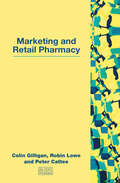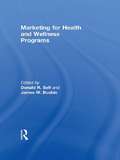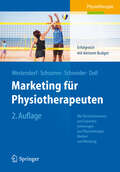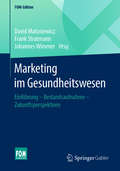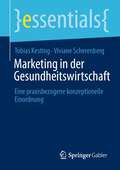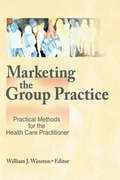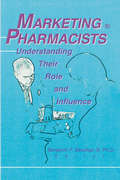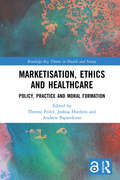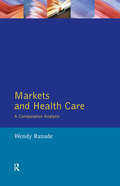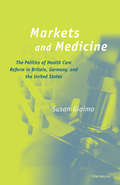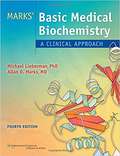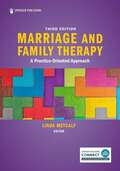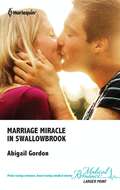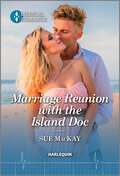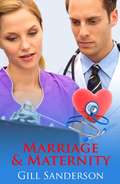- Table View
- List View
Marketing Implant Dentistry
by Marcus HinesA large percentage of skilled dental professionals lack the tools and comfort level required to market themselves and their dental implant practices effectively As a consequence, these dental professionals miss several opportunities to help patients and grow their business. Even those who recognize the need for marketing often don't have the experience or training to do so effectively. Marketing Implant Dentistry meets this need by giving dentists the tools to better market and promote their practices and to gain case acceptance.Marketing Implant Dentistry presents proven approaches for attracting dental implant patients and demonstrates the use of successful communication skills, including verbal and visual aids. This book details multiple examples of patient friendly and professional letters for use in targeting both new implant patients and professional referral sources. Readers will learn the benefits of adopting non-traditional approaches such as hosting patient education seminars, as well as cultivating professional relationships with the medical community (physicians) for the purposes of generating untapped referral relationships. Best practices in internet and social media marketing, specific to implant dentistry, are also demonstrated so practices can make the most out of these low-cost opportunities.
Marketing Long-Term and Senior Care Services
by William WinstonHere is detailed, practical advice for the administrator or practitioner of long-term and senior care services. Experts offer effective techniques for increasing the visibility and scope of those services through modern marketing practices.
Marketing Mental Health Services to Managed Care
by William Winston Norman Winegar John BistlineManaged care is rapidly making traditional marketing strategies for mental health services obsolete. Here is the definitive book that helps professionals understand contemporary market forces and how to reshape marketing strategies in an increasingly competitive environment.Marketing Mental Health Services to Managed Care begins by demystifying the seemingly bewildering world of managed care systems. It enables the reader to become a fully informed partner in providing services for managed care systems. In an era in which many professionals are affiliated with one or more managed care networks, this book guides clinicians toward greater control of their professional futures by providing the steps necessary to develop a successful managed care oriented practice strategy. It will be especially helpful to the newcomer to practice in the 1990s or the seasoned practitioner interested in increasing referrals from managed care systems.Readers of this highly practical new book learn how to analyze the market for clinical services, how to plan and develop services for the managed care market, and how to sell professional services in an era dominated by active payor entities. The increased importance of automation, group practices, and effective office management skills are discussed. Although of particular value to outpatient practitioners, Marketing Mental Health Services to Managed Care also discusses marketing strategies and revenue generating ideas for inpatient mental health and substance abuse treatment facilities. Program managers, administrators, and marketing professionals in the hospital industry will find this book a valuable investment.Of special interest to all readers are chapters addressing the impact of managed care systems--with their focus on accountability, cost-effectiveness, and quality--upon traditional clinical paradigms. Brief therapy skills and techniques are discussed by these two veteran clinicians and writers. Emerging clinical innovations and effective reimbursement strategies are also discussed in this remarkable new book. A resource section, managed care company directory, and a glossary of terms make this a practical guidebook of long-lasting value to professionals from many disciplines. College professors and graduate students will also find Marketing Mental Health Services to Managed Care a valuable introduction to marketing professional services in the managed care dominated marketplace for healthcare today.
Marketing Social Change. Changing Behavior to Promote Health, Social Development, and the Environment
by Alan R. AndreasenApplies marketing techniques to social issues.
Marketing and General Practice
by Colin Gilligan Robin LoweThis book deals with the area of marketing in general practice. It presents a step-by-step guide to the nature of marketing in which each aspect is presented in short, separate chapters accompanied by questions, checklists and practical examples. It is based upon the lessons learned by a number of GPs and practice managers over a variety of situations and concludes with a comprehensive case study of one particular practice with which the authors worked. Readers of this book should gain a clear idea of the nature and purpose of marketing techniques and how the opportunities now becoming available can benefit both practice and patients.
Marketing and Healthcare Organizations
by Colin Gilligan Robin LoweThe need for a more conscious, focused and proactive approach to the management of health-care organizations has increased substantially. One consequence of this is that health-care managers are having to look at managerial approaches and techniques that previously were the province of the private sector. Prominent among those is the whole area of marketing. This work takes a broad approach to the marketing process, highlighting some of the challenges that health-care managers and medical professionals are having to face. Having done this, the authors move on to examine some of the characteristics of good and bad management practice. It is against this background that, in subsequent chapters, they turn their attention to the question of marketing and how it might best contribute to the management of organizations throughout the health sector. Each chapter includes questions and checklists offering scope for applying marketing principles to primary and secondary health-care organizations of all types, sizes and specialities.
Marketing and Retail Pharmacy
by Colin Gilligan Robin Lowe Peter CatteeBased on the authors' experiences of working with a wide variety of retail pharmacies, this book is designed to provide pharmacists with a clear understanding of the nature of marketing, and the ways it can contribute to the effective management of their business. It explains how marketing techniques can benefit retail pharmacy, and includes questions and checklists, examples and case histories.
Marketing for Health and Wellness Programs
by Donald Self James BusbinLearn useful strategies for marketing health and wellness programs. This important new book presents a cross-section of current research and commentary on wellness and prevention issues. The 17 authors--representing 11 different institutions--are some of the most active health care consultants in the academic community. They discuss studies for hospital based programs, workplace programs, and governmental and educational institutions.Important marketing concepts are used to segment the work into several sections. Included are chapters which help to define the actual product lines which should be grouped into wellness and prevention programs, studies that define several important market segments, and chapters on channels of distribution. This timely volume concludes with an analysis of current research efforts and directions for future research.Marketing for Health and Wellness Programs is essential reading for hospital administrators, faculty physicians at teaching hospitals, public health professors, government health service administration employees, corporate managers and personnel administrators, insurance industry managers, independent health and wellness consultants, and staff members of health trade publications.
Marketing für Physiotherapeuten: Erfolgreich mit kleinem Budget. Mit Rechtshinweisen und Expertenmeinungen aus Physiotherapie, Medien und Werbung
by Alexandra Schramm Christian Westendorf Johan Schneider Ronald DollErfolgreich in der eigenen Praxis mit gezieltem Marketing! Zunehmende Konkurrenz verbunden mit Kürzungen von Budgets fordern auch von Physiotherapie-Praxisbesitzern ein gezieltes Marketing, um auch weiterhin erfolgreich sein zu können. Profitieren Sie vom Expertenwissen des Autorenteams aus der Physiotherapie, dem Marketing und dem Praxisrecht: - Grundlagen von Marketing - Marketingmethoden gezielt einsetzen - Von der Marktforschung profitieren - Marketingziele für die eigene Praxis formulieren - Nutzung von Social Media und Internet Die 2. Auflage wurde komplett aktualisiert und vertieft, u.a. um spezielle Marketinginstrumente wie Pressearbeit, interkulturelles Marketing oder die Erschließung von Fördergeldern. Plus: Expertenkommentare mit Empfehlungen und Warnhinweisen Ein nützlicher Ratgeber für Physiotherapeuten und Praxisinhaber, die mit kleinem Marketing-Budget Ihre Ziele erreichen wollen.
Marketing im Gesundheitswesen: Einführung - Bestandsaufnahme - Zukunftsperspektiven (FOM-Edition)
by Heribert MeffertMarketing ist eine zunehmend wichtige Disziplin im Gesundheitswesen. In diesem Buch präsentieren Experten aus den Disziplinen Marketing und Gesundheitsökonomie den Status quo wie auch die Zukunftsperspektiven für das Marketing im dynamischen Healthcare-Sektor. Sie zeigen, wie sich das Marketingverständnis von einer operativen Technik zur Beeinflussung der Kaufentscheidung zu einer Führungskonzeption entwickelt hat, die andere Funktionen wie zum Beispiel Beschaffung, Produktion, Verwaltung und Personal von Gesundheitsakteuren mit einschließt. Die Gesundheitsakteure befinden sich in einem Transformationsprozess von einer Verwaltungsbehörde hin zu modernen Gesundheitsmanagementunternehmen. Allerdings liegt die Gesundheitsbranche nüchtern betrachtet dem Handel um rund zehn Jahre zurück. Hierbei stellen sich immer wieder Fragen wie: Braucht eine Arztpraxis heute einen Social-Media-Auftritt? Lohnt es sich für ein Krankenhaus, in Zuweisermarketing zu investieren? Wie können sich Krankenkassen in einem stark regulierten Markt voneinander abgrenzen? Wie kann die Pharmaindustrie ihr Image verbessern? Wie lösen wir das Spannungsfeld Patient, Klient und Kunde? Fakt ist auch: die Digitalisierung im Gesundheitswesen wird das Marketing auf ein neues Level heben. Das klassische Agenturgeschäft wird zunehmend von IT-Konzernen wie IBM, Apple und Google angegriffen, die ganzheitliche Lösungen bieten. Dieses Buch geht diesen und weiteren Themen nach und bietet so sowohl den Praktikern der Gesundheitsbranche als auch Studierenden der Gesundheitswissenschaften ein fundiertes Grundlagenwerk zum "Marketing im Gesundheitswesen".
Marketing in der Gesundheitswirtschaft: Eine praxisbezogene konzeptionelle Einordnung (essentials)
by Viviane Scherenberg Tobias KestingDas essentials widmet sich der systematischen Kategorisierung des Marketings in der Gesundheitswirtschaft, welches durch eine Vielzahl an Zielgruppen, Akteuren, Zielsetzungen und Produkten bzw. Dienstleistungen gekennzeichnet ist. Es zielt auf eine praxisorientierte konzeptionelle Einordnung dieses Marketings auf wissenschaftlicher Grundlage ab. Hierzu werden thematisch relevante Begriffe erläutert und Kategorisierungen nach verschiedenen Dimensionen vorgenommen. Zudem erfolgt eine Darlegung und Adaption von Marketingansätzen zur Verwendung in der Gesundheitswirtschaft. Als Ergebnis werden Leitfragen und eine Bezugsmatrix erstellt, die ein systematisches Vorgehen für angewandtes Marketing in Wissenschaft und Praxis der Gesundheitswirtschaft ermöglichen.
Marketing the Group Practice: Practical Methods for the Health Care Practitioner
by William WinstonA practical guide for providers and administrators in the health industry, this stimulating volume explains how to effectively use a variety of marketing practices such as advertising, public relations, fund raising, and “word of mouth” from satisfied clients.
Marketing to Pharmacists: Understanding Their Role and Influence
by Benjamin F BanahanMarketing to Pharmacists: Understanding Their Role and Influence will help pharmaceutical marketers better understand pharmaceutical practice in order to develop better relationships with pharmacists and effectively market products. This book examines important trends in pharmaceutical health care, including patient education and compliance, quality of life assessment, disease management, and cost containment strategies that assist pharmacists in providing better care to patients which results in increased sales for your business. From Marketing to Pharmacists, you?ll learn how pharmacists influence product selection, monitor drug therapy, and serve as a primary source of patient education in order for you to create successful marketing strategies for your company. Recognizing that cost control is a key goal for all members of the health care system, Marketing to Pharmacists provides you with advice and strategies that emphasize working together with pharmacists. This will help you determine demand for a specific product so you can devise your own marketing strategies to meet the needs of both the pharmacist and patient. With Marketing to Pharmacists, you?ll improve your marketing skills by using innovative techniques and suggestions, including:understanding pharmacists’influence in prescription product selection to help develop effective marketing strategiesasking for pharmacists’assistance in designing care management programs, participating in the development and negotiation of care management contracts, and offering knowledge as pharmacotherapeutic experts to emphasize patient advocacy and accessibility to patientsunderstanding the dimensions of the quality of life and other aspects of pharmaceutical care to design effective sales tactics to pharmacistscommunicating with pharmacists to learn about the needs of certain patients in order to create effective marketing strategies that will lessen the occurrence of unclaimed prescriptions and decrease the loss of revenue to pharmaceutical companiesdeveloping a positive relationship between pharmacists and pharmaceutical companies by displaying genuine customer interest, providing pharmacists with useful and accurate information about products, and establishing ethical guidelinesContaining charts, tables, and graphs to give you a comprehensive look at techniques and data, Marketing to Pharmacists will help you create marketing strategies that will successfully meet the needs of your customers and result in economic benefits for your company.
Marketisation, Ethics and Healthcare: Policy, Practice and Moral Formation (Routledge Key Themes in Health and Society)
by Andrew Papanikitas Therese Feiler Joshua HordernHow does the market affect and redefine healthcare? The marketisation of Western healthcare systems has now proceeded well into its fourth decade. But the nature and meaning of the phenomenon has become increasingly opaque amidst changing discourses, policies and institutional structures. Moreover, ethics has become focussed on dealing with individual, clinical decisions and neglectful of the political economy which shapes healthcare. This interdisciplinary volume approaches marketisation by exploring the debates underlying the contemporary situation and by introducing reconstructive and reparative discourses. The first part explores contrary interpretations of ‘marketisation’ on a systemic level, with a view to organisational-ethical formation and the role of healthcare ethics. The second part presents the marketisation of healthcare at the level of policy-making, discusses the ethical ramifications of specific marketisation measures and considers the possibility of reconciling market forces with a covenantal understanding of healthcare. The final part examines healthcare workers’ and ethicists’ personal moral standing in a marketised healthcare system, with a view to preserving and enriching virtue, empathy and compassion. Chapters 4 and 7 of this book are freely available as downloadable Open Access PDFs at http://www.taylorfrancis.com under a Creative Commons Attribution-Non Commercial-No Derivatives (CC-BY-NC-ND) 4.0 license.
Marketplace of the Marvelous
by Erika JanikAn entertaining introduction to the quacks, snake-oil salesmen, and charlatans, who often had a point Despite rampant scientific innovation in nineteenth-century America, traditional medicine still adhered to ancient healing methods such as induced vomiting and bleeding, blistering, and sweating patients. Facing such horrors, many patients ran with open arms to burgeoning practices promising new ways to cure their ills: Hydropaths promised cures using "healing tubs." Franz Anton Mesmer applied magnets to a patient's body, while Daniel David Palmer restored a man's hearing by knocking on his vertebrae. Phrenologists emerged, claiming the topography of one's skull could reveal the intricacies of one's character. Bizarre as these methods may seem, many are the predecessors of today's notions of health. We have the nineteenth-century practice of "medical gymnastics" to thank for today's emphasis on daily exercise, and hydropathy's various water cures gave us the notion of showers and the mantra of "eight glasses of water a day." These early medical "deviants," including women who had been barred from the patriarchy of "legitimate doctoring," raised questions and posed challenges to established ideas, and though the fads faded and many were discredited by the scientific revolution, some ideas behind the quackery are staples in today's health industry. Janik tells the colorful stories of these "quacks," whose shams, foils, or genuine wish to heal helped shape and influence modern medicine.
Markets and Health Care: A Comparative Analysis
by Wendy RanadeA growing reliance on market disciplines and incentives characterised health care reform strategies in many countries in the 1990s, yet the country which relies most heavily on private health care - the U.S.A. - is the most expensive in the world and still fails to deliver affordable health care to millions of its citizens. This apparent paradox is the starting point for Markets and Health Care: A Comparative Analysis.
Markets and Medicine: The Politics of Health Care Reform in Britain, Germany, and the United States
by Susan GiaimoAre advanced industrialized countries converging on a market response to reform their systems of social protection? By comparing the health care reform experiences of Britain, Germany, and the United States in the 1990s, Susan Giaimo explores how countries pursue diverse policy responses and how such variations reflect distinctive institutions, actors, and reform politics in each country. In Britain, the Thatcher government's plan to inject a market into the state-administered national health service resulted in a circumscribed experiment orchestrated from above. In Germany, the Kohl government sought to repair defects in the corporatist arrangement with doctors and insurers, thus limiting the market experiment and designing it to enhance the solidarity of the national health insurance system. In the United States, private market actors foiled Clinton's bid to expand the federal government's role in the private health care system through managed competition and national insurance. But market reform continued, albeit led by private employers and with government officials playing a reactive role. Actors and institutions surrounding the existing health care settlement in each country created particular reform politics that either militated against or fostered the deployment of competition. The finding that major transformations are occurring in private as well as public systems of social protection suggests that studies of social policy change expand their focus beyond statutory welfare state programs. The book will interest political scientists and policymakers concerned with welfare state reform in advanced industrial societies; social scientists interested in the changing balance among state, market, and societal interests in governance; and health policy researchers, health policymakers, and health care professionals.
Marks' Basic Medical Biochemistry (Fourth Edition): A Clinical Approach
by Michael A. Lieberman Alisa Peet Allan MarksMarks’ Basic Medical Biochemistry takes a patient-oriented approach that links biochemistry to physiology and pathophysiology, allowing students to apply fundamental concepts to the practice of medicine—from diagnosing patients to recommending effective treatments. Intuitively organized chapters center on hypothetical patient vignettes and helpful icons allow for smooth navigation, making complex concepts easier to grasp!
Marks' Basic Medical Biochemistry: A Clinical Approach
by Alisa Peet Michael LiebermanConnect biochemistry to clinical practice! Marks’ Basic Medical Biochemistry links biochemistry to physiology and pathophysiology, allowing students to apply fundamental concepts to the practice of medicine – from diagnosing patients to recommending effective treatments.
Marks' Basic Medical Biochemistry: A Clinical Approach
by Michael A. Lieberman Alisa PeetMarks’ Basic Medical Biochemistry: A Clinical Approach, 6th Edition links biochemistry to physiology and pathophysiology, empowering students to confidently apply fundamental concepts to the practice of medicine — from diagnosing patients to recommending effective treatments. This proven, application-centered approach builds biochemical coverage around related clinical concepts to anchor students’ understanding to a clinical context from day one. Intuitively organized chapters center on hypothetical patient vignettes to emphasize clinical applications, and helpful icons, images, and review questions make complex concepts easier to grasp.
Marriage And Family Therapy: A Practice-oriented Approach
by Linda MetcalfLearn how to take different models of therapy from theory to real world practice Delivering proven therapeutic strategies that can be used immediately by students of marital and family therapy, this text brings 15 modern and postmodern therapy models to life through guiding templates and interviews with master therapists. The text progresses step-by-step through marriage and family essentials, describing in detail the systemic mindset and basic terminology used by the marriage and family therapist. Interviews with such master therapists as Albert Ellis, David V. Keith, and Mariana Martinez―who each provide commentary on a single case study―give readers the opportunity to observe different models in action, clarifying theory and practice simultaneously. Instructive templates for each model illuminate the nuts and bolts of the therapy process and help instructors bring content to life, so students can visualize and practice the process. The updated third edition presents new interviews with master therapists, a new case study that reflects the modern-day client, and a section on social justice in each chapter. Also featured in the third edition are links to valuable new websites, recommended reading for in-depth study of each model, and an updated Instructor Manual, Test Bank, and Instructor Chapter PowerPoints. Audio and Video content are also available for chapters focusing on therapy models to dive deeper into practical application, interviews, and role play. Purchase includes online access via most mobile devices or computers. New to the Third Edition: New chapters on social justice, teletherapy practices, marriage and family therapy in times of crisis including COVID-19, and the advantages of an accredited program New interviews with master therapists who are evolving the systemic mindset, including an updated case study that reflects the contemporary client A section on social justice for each therapy model Audio and video content with interviews, discussions, and role play to enhance learning Key Features: Provides a guiding template for each model from assessment through termination Introduces the theory, history, theoretical assumptions, techniques, and components of each paradigm Delivers numerous interviews, case study commentaries, and analyses by prominent master therapists Provides theory and practice on supervision, research, ethics, and self-care of the therapist
Marriage Miracle in Swallowbrook
by Abigail GordonThe husband she's never forgotten...Laura Armitage's heart broke the day she said goodbye to her husband, top oncologist Gabriel-but how could she stay in a marriage where she always came second to his career? Only, now Gabriel has joined Laura in the beautiful Lakeland village of Swallowbrook, and is determined to prove he's never stopped loving her...
Marriage Reunion in the ER (Bondi Beach Medics #4)
by Emily ForbesWill the trauma surgeon be able to convince his estranged wife to start over again? Find out in the gripping final installment of the Bondi Beach Medics quartet by Emily Forbes.One chance……to win back his wife! Locking eyes over a patient isn&’t how ER doctor Lily expected to be reunited with her estranged husband, Otto. Two years ago, she lost their baby and fled to Sydney, unable to share her grief. And as far as Lily&’s concerned, their marriage is all but over. Yet trauma surgeon Otto is ready to fight for their relationship. Now he has three months to convince Lily they can make a fresh start…From Harlequin Medical: Life and love in the world of modern medicine. Bondi Beach MedicsBook 1: Rescuing the Paramedic's HeartBook 2: A Gift to Change His LifeBook 3: The Perfect Mother for His SonBook 4: Marriage Reunion in the ER
Marriage Reunion with the Island Doc
by Sue MacKayBeing stuck at a destination wedding with her ex-husband isn&’t the holiday she had planned! Find out if this could be their second chance in the latest Harlequin Medical Romance from Sue MacKay. A SECOND CHANCE IN PARADISE? At a destination wedding, nurse Alyssa is hoping for a stress-free break. But the best man is her ex-husband, island GP Leighton! Their whirlwind marriage collapsed as quickly as it began when Leighton suddenly withdrew from her. Alyssa never understood why, and now that they&’re stuck together for a fortnight, she wants to find out! Will her dream holiday end in closure…or a romantic reunion?From Harlequin Medical: Life and love in the world of modern medicine.
Marriage and Maternity
by Gill SandersonSister Angel Thwaite's neo-natal unit saves the life of an orphaned baby . To her horror she discovers that the baby's only relation is the baby's uncle, Dr Mike Gilmour has just started work in her hospital's cardiac unit. Mike is the surgeon who has to treat Angel's mother for a cardiac problem and eventually operate on her. He is also her ex-husband. Seven years ago they parted on bad terms.
